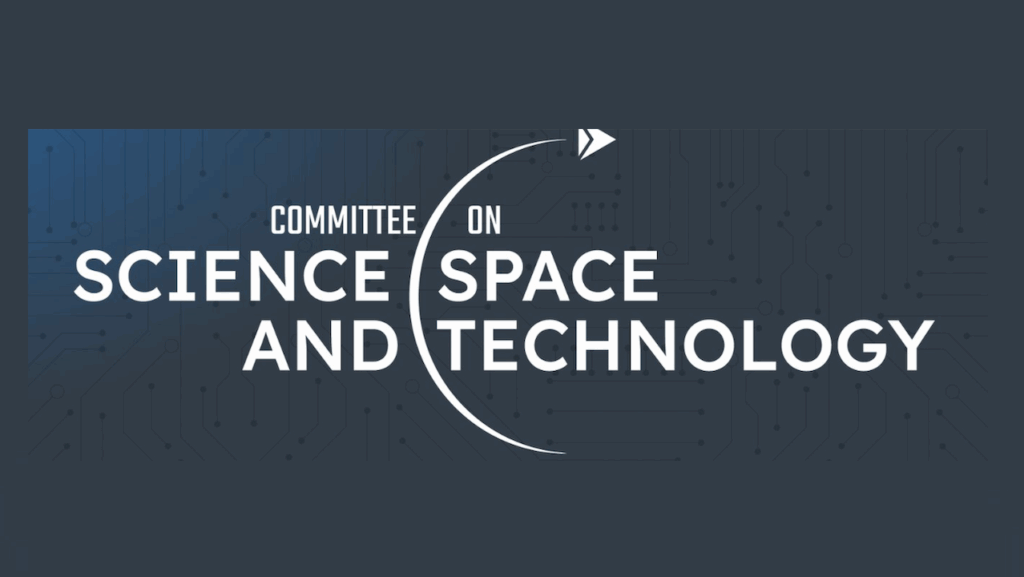New Space Authorization Bill Introduced In The House

Full text
Committee Members Introduce NASA Authorization Legislation
“This afternoon, Space and Aeronautics Subcommittee Chairwoman Kendra Horn (D-OK) along with Space and Aeronautics Subcommittee Ranking Member Brian Babin (R-TX), Chairwoman Eddie Bernice Johnson (D-TX), and Ranking Member Frank Lucas (R-OK) introducedH.R. 5666, the “National Aeronautics and Space Administration Authorization Act of 2020.” H.R. 5666 reaffirms NASA’s foundational authority as a multi-mission agency and emphasizes the importance of balanced exploration, science, aeronautics, technology, and education portfolios. The Act establishes frameworks that put a premium on planning, oversight, transparency, and responsible fiscal and program management.”
Markup of: HR 5666, the “National Aeronautics and Space Administration Authorization Act of 2020”
Excerpts:
“– The goal of NASA’s Moon to Mars program shall be to land humans on Mars in a sus9 tainable manner as soon as practicable. The Moon to Mars program shall have the interim goal of sending a crewed mission to the lunar surface by 2028 and a goal of sending a crewed mission to orbit Mars by 2033.
— In order to reduce risk and complexity and make maximum use of taxpayer investments to date, the Administrator shall in the conduct of the Lunar Precursor Initiative employ an architecture that utilizes the Orion vehicle and an integrated lunar landing system carried on an Exploration Upper Stage-enhanced Space Launch System for the human lunar landing missions. The Gateway to Mars shall not be required for the conduct of human lunar landing missions.
– The Administrator shall establish a Moon to Mars Program Office within 60 days of the enactment of this Act to lead and manage the Moon to Mars program.
– The Administrator shall complete development of the Space Launch System and the Space Launch System variant enabled by an Exploration Upper Stage, pursuant to section 302 of the National Aeronautics and Space Administration Authorization Act of 2010. The Administrator shall take steps to develop the Block 2 variant to provide the full range of launch capability and performance available to the United States for the Administration’s crewed and robotic exploration of deep space. The Administrator shall complete the development and testing of the Exploration Upper Stage for the Space Launch System.
— Within 120 days of the date of enactment of this Act, the Ad3 ministrator shall develop an overall architecture and plan, consistent with sections 203(c)(1) and 203(c)(2), including— (A) a list of the minimum set of human and robotic lunar surface activities that must be completed to enable a human mission to Mars, including those to be tested on the Gateway to Mars, along with a plan for completing those tasks within five years after the first human lunar landing; and (B) a list of the capabilities and risk re14 duction measures listed in section 203(f)(3).
– five-year funding estimates and profiles for the Moon to Mars Program. The budget profiles should include estimated funding requirements and profiles for the program elements in section 203(f), and related infrastructure, facilities, and operations that are consistent with the achievement of a crewed mission to Mars orbit by 2033
– Any establishment of a continuously crewed lunar outpost or research station shall not be considered an element of the Moon to Mars Program and shall be budgeted separately from the Moon to Mars program. (b) OTHER CREWED ACTIVITIES.–Crewed activities on or around the surface of the Moon that do not contribute to the goal of landing humans on Mars in as sustainable manner as practical shall not be included in the Moon to Mars Program and shall be budgeted separately from the Moon to Mars Program. (c) LUNAR IN-SITU RESOURCE UTILIZATION.– Lunar in-situ resource utilization shall not be considered as risk reduction for the initial crewed missions to orbit and land on Mars. Any lunar in-situ resource utilization activities and shall not be included in the Moon to Mars Program and shall be budgeted separately from the Moon to Mars Program.”









One of the few bipartisan places in Congress. May it remain so.
Added later:
This would be an example of what I call policy via the Seems Like Fallacy. In this case, Seems Like getting to Mars from the moon is logical since the moon is closer.
But even lightly informed observers know that this isn’t the case, at least not entirely; there are strong arguments based on cost, on orbital mechanics, and in the kind of kit needed for two very different missions.
I see this in my very small world: folks claim, with an air of authority: seems like native plants are natural! No chemicals, or fertilizer needed! And of course that’s not the case.
Or: I don’t want new development around me! Seems like Florida’s a big place so build someplace else! And, again, in-fill, as we call it, has enormous cost savings in utility provision, environmental protection, and more.
But who can argue with Seems Like?
Pork has always been bipatisan and this bill is just “pork on steroids”. The only reason the Moon landing has been included is that someone realized a lunar lander will increase the pork to be shared. And of course like SLS, Gateway, Orion and Mars the date for the landing will keep slipping so the pork will flow forever.
The only way the new graduating class of NASA will make it to the Moon under this bill will be by hiring on as tour guides on SpaceX’s Starship.
Yea. The world is full of wishful thinking. I was at a meeting about possible robotic missions to Uranus or Neptune last week. The timeline is not good. By the time NASA and ESA could decide to formally start such a mission (2023 or later), it’s probably going to be too late. The good launch windows for Neptune end in 2030, and for Uranus in 2034.) That’s not enough time to design, build and launch a flagship mission following the usual development process. But people are always optimistic. I was saying those launch windows didn’t consider a Falcon Heavy with a kick stage, made some assumptions that aren’t necessarily true, and we could probably manage something launching as late as 2036 or so. That might be wishful thinking. On the other hand, quite a few people at the meeting were saying, “Well, what if we could launch on a SLS?” And there weren’t many people willing to stand up and say that was _really_ wishful thinking.
With a plan like this the only way they are getting to Mars by 2033 is to buy a ticket from SpaceX.
Rockets aren’t the obstacle for getting to Mars. We have had capable enough rockets for about 60 years now
We’re talking about getting people to Mars and landing them on the surface. They’ll be spending all their money on SLS and a lunar lander through at least 2028. I don’t see them developing their Mars spacecraft in five years. Unless you think they’re going to get enough budget to develop both simultaneously.
Yes, but Starship/SuperHeavy is a rocket for much more than just getting the necessary mission hardware and people to orbit.
Starship is not just a rocket, it’s also a spaceship/lander.
Lunar by 2028?? I thought the goal was 2024. Also…why say the following:
…architecture that utilizes the Orion vehicle and an integrated
lunar landing system carried on an Exploration Upper Stage-enhanced
Space Launch System for the human lunar landing missions.
Landing humans (back) on the Moon by 2024 was just the administration’s goal. Congress thinks a bit more rationally here; 2024 is not going to happen.
The definition of the architecture returns us to an Apollo-style LOR expedition (with the EUS remaining attached until Lunar Orbit Injection?). It is a bit confusing, as Orion does not have the ΔV to accomplish this on its own.
The 2024 goal might have been self-serving on Trump’s part, but it was also a way of ensuring there was at least a fighting chance of a landing sometime in the mid-2020’s, because NASA timelines slip to the right.
A 2028 deadline basically means it will probably happen in the early 2030’s, if at all.
Why say that? Because Boeing wants the extra money to develop EUS, however poor a choice they are for that task and however much it would delay the overall program.
Education will get a budget equal to the other areas? Last time I looked it was a hundred times smaller.
Did you see the language on Europa Clipper (Sec. 334), Keith?
Seems like a reasonable trade, from the SLS mafia’s point of view. Stop holding Europa Clipper hostage to SLS, in exchange for holding the entire Lunar program hostage to SLS/EUS.
Though I note there’s also language about maybe putting Europa Clipper on SLS after all, if SLS launch rate is (for yet more billions) boosted high enough to support a couple SLS launches a year for Moon/Mars plus a few extra flights here and there. So Clipper isn’t entirely off the hook yet.
How does the agency with any credibility get to Mars orbit by 2033 after just getting to lunar surface for a short duration sortie 2028? What is the rush to get to Mars? Why is congress and some like Marshall Smith pushing a turn and burn from moon2mars? A 500 day Martian surface mission would learn a lot from some long duration lunar stays practicing additive manufacturing, robotic caretakers, isru, MCC in a box and more. How does any of that get run time before Mars if they are just getting to the moon 5 years earlier with a once a year SLS/Orion flight tempo?
Well, actually, there is no rush.
They had to pick a date close enough to actually seem relevant, but not so close that there’s any serious danger of needing to be worked on or funded right away, either.
Exactly. It is more effective to spend money pretending to go to Mars that it is to use existing capability and design & build a lander to reach the Moon. You don’t have to deliver anything yet. SLS is the perfect vehicle for that. =)
It also says something about a permanent (long-term) lunar surface presence and the use of lunar volatiles (ice). The plans for a 2033 Mars landing shall not assume the use of either.
Looks like the SLS Forever budget – mandates development of EUS plus the Block 2 upgrades, and also mandates their use for any Lunar landings – specifically in lieu of using Gateway to assemble landing missions launched on other boosters.
And overall, it steers the program away from near-term Lunar development goals and toward a longer-term (if not indefinite) Mars landing. Thus lengthening the SLS funding window to essentially forever. Nice! If you’re getting some billions a year to develop SLS, that is. Not so nice for actual useful exploration.
By the time Boeing starts work on the EUS and the integrated Lunar lander. SLS will died as the first SpaceX Starship fly around the Moon. And the realization that some paying customer will be the first woman walking on on the Moon, if NASA don’t
buybeg a ride with SpaceX first. Heck there could even been customer inquiries to when and for how much for a ride to the Moon already.yup.
Ah well. It was a nice dream while it lasted. All of 10 months. A dream of NASA relevancy to manned space exploration.
Now all we have left to pin our hopes on are the Space Billionaires private businesses, SpaceX and Blue Origin.
Thanks for nothing, Congress. Thanks for inventing new ways of wasting decades of time and hundreds of billions of dollars.
This is essentially a double handful of senior congress critters bleeping over the NASA budget to steer bucks to their districts despite cost to the taxpayers. In short, absolutely business as usual, in DC. If you think this is bad don’t even try and look at the DOD budget. Warren Magnuson and Bobby Byrd, to name two, did this kind of thing for eons.Tom Bevill and Jack Murtha were both named “kings of pork” for such diversions of taxpayer funds to their local interests (by the NY Times and CBS news respectively) So absolutely nothing new in congressional spending patterns.
Forgive my ignorance….does this kill Gateway?
No. It says Gateway is for Mars missions only.
If this or anything like it is approved, I will resign from the National Space Council’s User Advisory Group. After years of me and so many others urging NASA to get out of LEO and go back to the moon and this time to stay, it would be too much to bear to now watch at close range it being ruined by a Mars fantasy, probably while other nations make a lunar land rush.
SLS is one huge dead end. Doesn’t matter if it’s being used to go to the moon or to Mars.
Besides, the whole moon vs. Mars thing is a false choice. We can, and should, be doing both. But we can’t afford either without first killing SLS and developing the necessary technologies for sustainable transportation like in situ propellant manufacturing and in orbit refueling of cryogenic propellants. Both of these technologies will be vital for any sustainable beyond LEO transportation system.
So what H.R. 5666 is really saying is that SLS pork is far more important to Congress than actual crewed missions beyond LEO. I suppose this is yet another reason to hate Boeing.
Instead of spending billions of dollars on stock buy-backs ($43 billion since 2013), Boeing should have been investing in development of KC-46, 737 Max, CST-100, and SLS. Instead, we can all see how these programs are all failing.
Cite for the $43 billion in stock buybacks:
https://marketrealist.com/2…
Boeing is “too big to fail”, so why not “maximize shareholder value” instead of actually delivering quality products on time.
Another, vital reason for landing humans on the Moon, AND establishing a permanent crewed base there is to investigate the long-term (over several years) effects of REDUCED-gravity on human physiology BEFORE attempting to send crews to Mars. Without such research, the likelihood is that crews reaching the Red Planet, orbiting, landing and returning to Earth will be seriously impacted (no pun intended) by the low gravity, high radiation environment of trans-Earth/Mars!
By the time Congress’ plan is accomplished, if it even does, the chances are SLS/Orion astronauts will be welcomed by commercial astronauts at their base on the Moon!
Ad Luna! Ad Ares! Ad Astra!
There is no reason to put humans on Mars except to say we did it. It is not the planet most people think it is. It is a —-hole which, even if we create the marching armies and amazing vehicles to go there, will only suck resources from Earth, never add to it. It would break our economic backs for nothing and leave corpses strewn from here to Olympus Mons. https://homerhickamblog.blo…
It has nitrogen and carbon, which a sustained presence requires and the Moon lacks.
The moon is next door and can add to our economic wealth. Mars is a distant money pit. No reasonable business plan can be made for it nor can the science gained justify the expenditure and lives that would have to be sacrificed. AI can explore Mars if it’s needed. Simply put, people living on Mars is a Lowellian fantasy for which too many otherwise intelligent people keep falling for again and again.
But you did not mention where people on the Moon would get those necessary raw materials for life support. Importing them from Earth would be very expensive. I’m looking at minimizing imported raw materials, not maximizing physical exports. I guess that’s because I’m more interested in a colony which could eventually become self-sustaining, rather than a colony which adds to the Earth’s economic wealth. But neither the imports nor the exports are issues which can be ignored.
Asteroids are a possible source as well. But the economic equation are the costs of transporting those elements to the Moon versus the value of products from the Moon shipped to the Earth. Similarly you have the cost of supporting settlements on Mars versus the value the Mars settlement sends to Earth. And just as the question on gravity we don’t have good numbers to plug in.
We don’t have any real numbers, but I think we can make three qualitative statements:
The required imports would be greater for the Moon than for Mars.
The transportation costs for physical exports would be greater for Mars would be greater than for the Moon.
Not all exports require physically transporting goods.
Yes, The required imports are likely greater per person, but the proximity of the Moon to the Earth means that many jobs could be done telebotically from Earth increasing the productivity of the lunar workforce.
Also many physical goods exported from the Moon could be exported by means that do not require the use of rockets (mass drivers, railguns, etc.) greatly lowering the cost of exports.
So really the next step is to wait for Starship and see what happens.
As for NASA, if President Trump is not re-elected the reset button will be hit again for HSF and NASA will go off in some other direction.
Your comment reminded me of a website (cannot find it now) “Rocketpunk” that said there is no reason to live there because it is barren and inhospitable just as we don’t see a huge land rush to the Gobi Desert because there is no good reason to live there.
I honestly think that’s a legal, not an environmental issue. Historically, people have been very willing to settle barren and inhospitable places, _if_ that let them get away from governments and societies they really couldn’t stand. At the moment, the Gobi is in the People’s Republic of China and in Mongolia. I can’t see that as a place people would go to escape from an over-controlling government.
You have no basis for saying that impact is “likely”. It is possible and we simply do not know how likely or unlikely it is. Saying we need to find out is fine, but saying the risk is “likely” is an unjustified exaggeration.